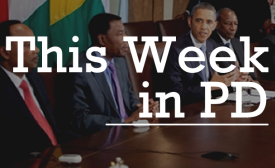aids diplomacy

This week, the US-Africa Leaders Summit took over Foggy Bottom to tackle issues of development, human rights, good governance, and economic growth.
When African leaders arrive in Washington this week to meet with President Obama, one of the most politically sensitive issues expected to be discussed is the future of the U.S. commitment to global efforts to deal with HIV/AIDS. For more than a decade, the United States has taken the lead in this fight, providing significant funding — $52 billion so far — to the cause through a program known as the President’s Emergency Plan for AIDS Relief (PEPFAR).
Health agencies are warning of an “alarming” increase in AIDS-related deaths among adolescents, a new front line in the fight against a global epidemic that has waned in recent years. This worrying new trend is a setback for efforts to eradicate the virus, according to a United Nations report released ahead of World AIDS Day on Dec. 1. Among youth aged 10 to 19, deaths linked to AIDS increased by 50 percent between 2005 and 2012, compared with a 30 percent decline seen in the general population.
Since 2004, the U.S. President’s Emergency Plan for AIDS Relief (PEPFAR) has funded HIV/AIDS prevention, care and treatment programs credited with extending the lives of millions of people in sub-Saharan Africa, including South Africa, which has received the majority of PEPFAR funding, reaching more than $500 million annually. In a place where a positive diagnosis of HIV/AIDS used to be a death sentence, America brought hope for longer lives.







